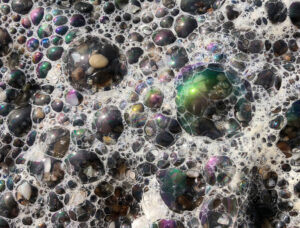Most of the state has set record temperatures this summer, but San Francisco has been cool and almost permanently cloudy because of its marine layer. And while Southern California is setting water temperature records, I heard the sea surface temperature was 49 degrees at Bodega Bay in early August. What’s going on? Why has it managed to be so cool, or at least, normal, in this small stretch of Northern California while it’s so extremely hot everywhere else?
Indeed San Francisco weather is dominated by its marine layer, directly from the ocean on the west but also from the north due to the marine air that enters the Bay through the Golden Gate gap. But in reality, the marine layer influences the coast all along California. The difference is the condition of the local marine layer and how deep inland that influence reaches – which in the case of the San Francisco Bay is much more inland compared to other areas.
Roughly from the Monterey Bay all the way to Cape Mendocino, the marine layer is particularly cold and foggy due to coastal upwelling. Coastal upwelling is the process by which the strong and persistent northwesterly winds bring deep and cold water to the surface at the coast. How they do that? With the aid of the Earth’s rotation (an effect called Coriolis): when surface water flows along the coast pushed by the winds, the Coriolis effect then deflects the flow to the right in the Northern Hemisphere, which around our coast happens to be offshore. The displaced coastal water is then replaced by water from depth, which is colder and incidentally full of nutrients that fuel our rich marine ecosystem. Once this deep water reaches the surface, it cools the air, too, leading to the formation of fog as water vapor condenses into droplets because colder air can “hold” less water than warm air.
Coastal upwelling occurs mostly in spring and summer, causing windy, foggy and cold conditions, especially in the Northern-Central California coast where winds are strongest. This is why summers are puzzling in San Francisco, and why the famous quote, apparently wrongly attributed to Ernest Hemingway and Mark Twain, still gets passed around so often: “The coldest winter I ever saw was the summer I spent in San Francisco.”
Coastal upwelling still occurs to the south, as the northwesterly wind blows all the way to Baja California, but it is weaker and the ocean water, even at depth, is warmer, so it does not have the same cooling effect over the coast as it does in Northern California. Also, Southern California weather is more influenced by the Southwest climate than the northern part of the state. This combination allows Southern Californians to enjoy sunny and warm days at the beach during the summer, even on windy days. To sum it up: the northern and southern coasts enjoy different climates, and the North Coast is particularly different from the rest of the state’s climate.
So in general, every summer there is a nice contrast between San Francisco and Southern California. But why does this year seem particularly extreme? Well, this is because both locations are experiencing a change in conditions — but in opposite directions. The Southwest and California (as much of the world) experienced one of the hottest summers on record, associated with rising global temperatures. But at the same time, in Northern California we are experiencing a decade of strong summer upwelling caused by strong winds. This summer we had the fifth strongest summer upwelling on record around Bodega Bay.
The northerly summer winds are themselves caused by an atmospheric high-pressure system over the ocean off California, and therefore linked to its strength and position. Scientists expect that the high-pressure system will migrate north with climate change, which will strengthen winds in northern areas. The strong summer winds we are experiencing now are part of an increasing trend observed since the 1940s only in Northern California, which is consistent with what we expect under rising global temperatures. So, yes, we are indeed experiencing more contrast between San Francisco and Southern California in the summer. And while it might not be every year, overall we expect it to happen more frequently.





